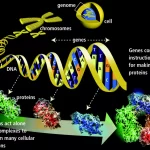
Bioinformatics research fields
September 29, 2006
Bioinformatics research fields broadly classified to the following sub-fields. Some research fields have inter related with one another
The term “sequence analysis” implies subjecting a DNA or peptide sequence to sequence alignment, sequence databases, repeated sequence searches, or other bioinformatics methods on a computer.
Sequence analysis in bioinformatics is an automated, computer-based examination of characteristical fragments. It basically includes five biologically relevant topics:
1. the comparison of sequences in order to find similar sequences (sequence alignment)
2. identification of gene-structures, reading frames, distributions of introns and exons and regulatory elements
3. prediction of protein structures
4. genome mapping
5. comparison of homologous sequences to construct a molecular phylogeny
structural bioinformatics refers to the analysis of macromolecular structure particularly proteins, using computational tools and theoretical frameworks.
GENOME ANALYSIS
It is defined as analysis of the full genomes of organisms that have been sequenced and to identify those genes that are predicted to have a particular biological function.Comparative genome analysis is one of the component of genome analysis.
Comparative genomics include a comparision of gene number,gene content and gene location in both prokaryotic and eukaryotic groups of organisms.
Gene expression, or simply expression, is the process by which a gene’s DNA sequence is converted into the structures and functions of a cell. Non-protein coding genes (e.g. rRNA genes, tRNA genes) are not translated into protein.
Gene regulatory network (also called a GRN or genetic regulatory network) is a collection of DNA segments in a cell which interact with each other and with other substances in the cell, thereby governing the rates at which genes in the network are transcribed into mRNA.
Mathematical models of GRNs have been developed to allow predictions of the models to be tested. Various modeling techniques have been used, including Boolean networks, Petri nets, Bayesian networks, graphical Gaussian models, Stochastic Process Calculi and sets of differential equations.
Systems biology is the coordinated study of biological systems by (1) investigating the components of cellular networks and their interactions, (2) applying exprerimental high-throughput and whole-genome techniques, and (3) integrating computational methods with experiemntal efforts.”
DATA AND TEXT MINING
Data mining (DM), also called Knowledge-Discovery in Databases (KDD) or Knowledge-Discovery and Data Mining, is the process of automatically searching large volumes of data for patterns such as association rules. It applies computational techniques from statistics, information retrieval, machine learning and pattern recognition.
phylogenetics (Greek: phylon = tribe, race and genetikos = relative to birth, from genesis = birth) is the study of evolutionary relatedness among various groups of organisms (e.g., species, populations). Also known as phylogenetic systematics, phylogenetics treats a species as a group of lineage-connected individuals over time.The most commonly used methods to infer phylogenies include parsimony, maximum likelihood, and MCMC-based Bayesian inference.
GENETICS AND POPULATION ANALYSIS
Genetic analysis: The study of a sample of DNA to look for mutations (changes) that may increase risk of disease or affect the way a person responds to treatment.
Population analysis: Population analysis encompasses methods used to characterize and understand changes in populations. Typically, through population analysis we are interested in being able to explain observed changes in population dynamics and make predictions regarding future possibilities. Knowledge from analyses is expressed as a model.
References:
- Bourne, Weissig (2003) Structural Bioinformatics, Wiley
- James M. Bower, Hamid Bolouri (editors), (2001) Computational Modeling of Genetic and Biochemical Networks Computational Molecular Biology Series, MIT Press, ISBN 0-262-02481-0
- Klipp E et al. ”Systems Biology in Practice”, WILEY-VCH, 2005
- Pang-Ning Tan, Michael Steinbach and Vipin Kumar, Introduction to Data Mining (2005), ISBN 0-321-32136-7
- http://en.wikipedia.org/wiki/Sequence_analysis
- http://en.wikipedia.org/wiki/Phylogenetics
















